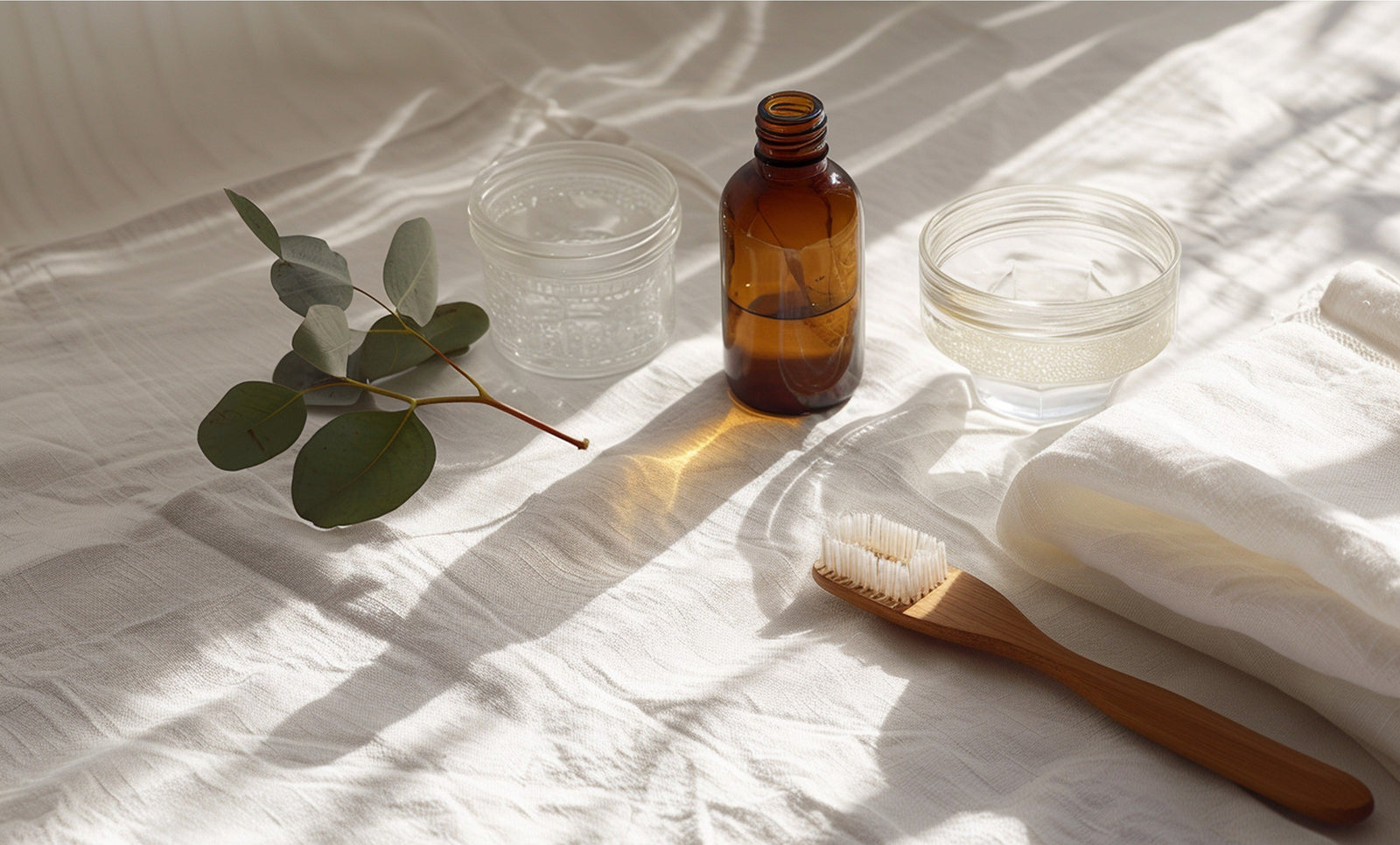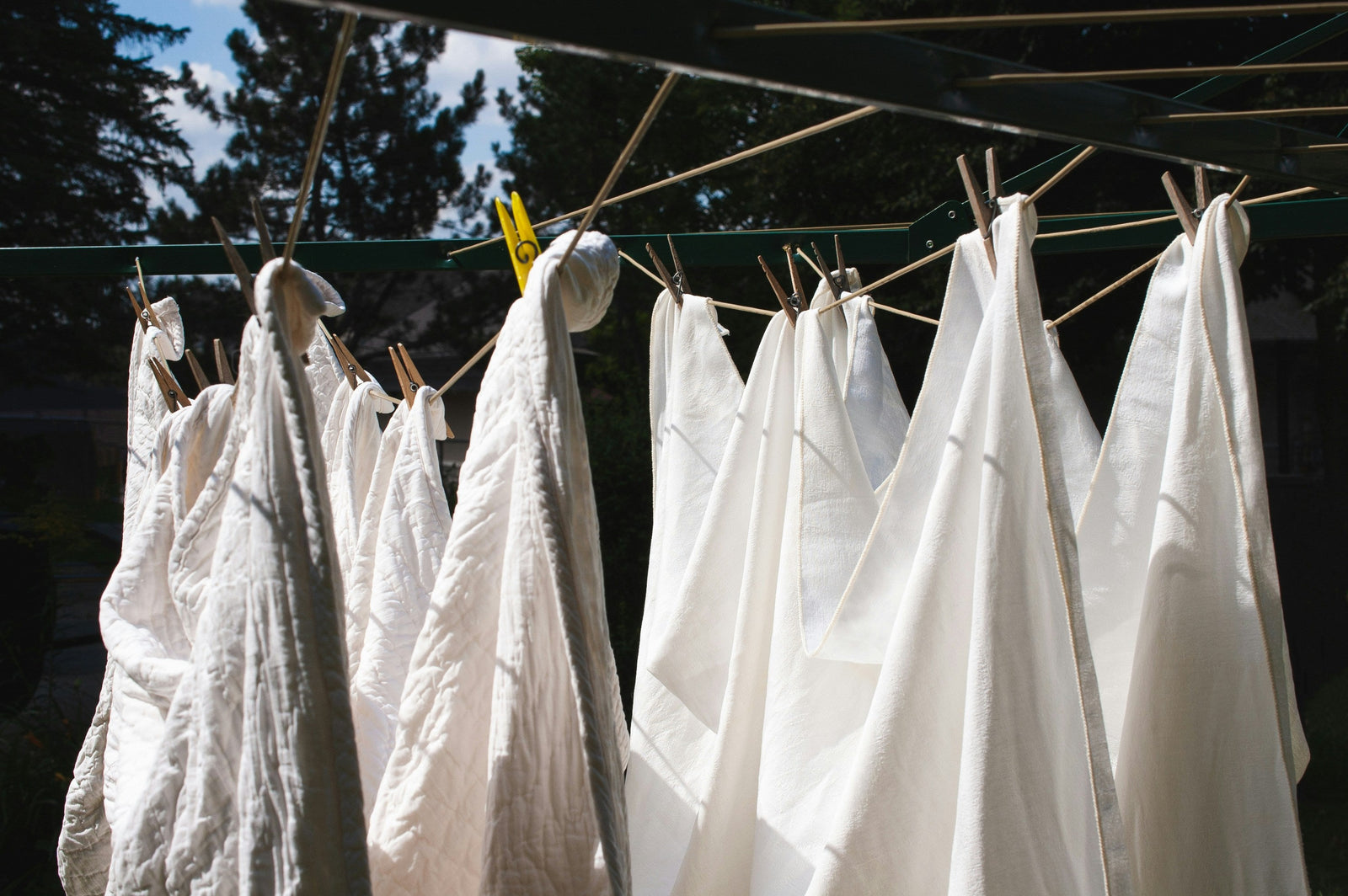How To Use Hydrogen Peroxide For Laundry: Complete Guide

If you’re looking for a safe and biodegradable chlorine bleach alternative, hydrogen peroxide is one of the best options.
Not only is it human-safe, eco-friendly, and pet-safe, but liquid or powdered peroxide is inexpensive, easy to use, and acts as a natural disinfectant.
In this article, you’ll learn how to use hydrogen peroxide for laundry, including to whiten and brighten clothes, remove stains, and keep your washer and dryer fresh, clean, and germ-free.
Hydrogen Peroxide Vs. Chlorine Bleach For Laundry
Many people stumble across peroxide for laundry when researching chlorine bleach alternatives.
So, what’s the difference?
Chlorine bleach is an EPA-registered pesticide and hazardous substance made up of sodium chloride and sodium hydroxide.
It is a highly corrosive and toxic chemical responsible for thousands of poisonings and injuries per day. It has been linked to reproductive toxicity, an increased risk of miscarriage, hormonal disruption, an increased risk of respiratory disorders in children, microbiome disruption, and is highly toxic to aquatic life.[1-4]
Chlorine is rated an eight on EWG Skin Deep.[5]
Hydrogen peroxide is made up of two hydrogen and two oxygen atoms (H2O2) and breaks down as such in our bodies and in the environment.
3% hydrogen peroxide (in the brown bottle) is so safe that it’s considered suitable for use in oral care products and organic aquaculture, and has been used for wound care for over 100 years (although it is no longer recommended due to its potential to irritate the skin).[5-9]
Although considered a bleach, hydrogen peroxide is a human- and pet-safe, environmentally friendly alternative that you can feel good about using in a low-tox home.
Hydrogen peroxide is rated two to five on EWG Skin Deep.[6] The rating depends on the percentage of hydrogen peroxide used and the use of the product.
The 3% hydrogen peroxide, as recommended in this article, would rate a two, which fits in our guideline to only keep products in the home with ingredients rated as one or two on EWG Skin Deep.
As a natural, low-tox bleaching agent, hydrogen peroxide can perform many of the same functions as chlorine bleach, including:
- Bleaching (whitening) clothing
- Disinfecting surfaces
- Removing stains
- Killing mold and mildew
- Brightening clothes
Plus, 3% hydrogen peroxide is incredibly inexpensive, typically less than $1.00 a bottle, making it one of the most affordable low-tox cleaners and disinfectants.
To learn more about the dangers of chlorine bleach, see: Is Sodium Hypochlorite (Bleach) Toxic? Dangers And Alternatives
Hydrogen Peroxide Vs. Branch Basics Oxygen Boost (With Sodium Percarbonate)
You have two options when using hydrogen peroxide for laundry:
- 3% hydrogen peroxide: Which is 3% peroxide and 97% water in the brown bottle
- Powdered peroxide: Also known as sodium percarbonate, found in Branch Basics Oxygen Boost
This article will cover both uses. If you’re new to sodium percarbonate, here’s a brief overview.
Sodium percarbonate is a powdered form of peroxide and one of two mineral-based ingredients in Branch Basics Oxygen Boost.
Both 3% hydrogen peroxide and sodium percarbonate are low-tox chlorine bleach alternatives and have comparable uses and benefits.
However, since Oxygen Boost has the added bleaching and deodorizing power of baking soda, it may work better on tough stains and tough soil.
As with all powdered products, take care not to inhale the powder.
Learn more in: The Power Of Sodium Percarbonate For Laundry
Safety Considerations When Using Hydrogen Peroxide For Laundry
Hydrogen peroxide is by far gentler and safer than chlorine bleach—on humans and on clothes! However, there are some things to be aware of before use.
Do not use hydrogen peroxide or sodium percarbonate on the following fabrics:
- Silk
- Wool
- Cashmere
- Colored fabrics (light-colored fabrics may be OK, but spot-test on an inconspicuous place first)
- Leather
- Suede
- Vintage fabrics
Never mix hydrogen peroxide with:
- Ammonia
- Chlorine bleach
- Rubbing alcohol
- Vinegar (all types)
- Other synthetic chemical cleaners
Peroxide can create a toxic gas when combined with these products.
It’s fine to use hydrogen peroxide with Branch Basics and baking soda.
Like all powdered products, do not inhale sodium percarbonate, as it can irritate the lungs.
It is safe to use peroxide or sodium percarbonate with your favorite laundry detergent (preferably, a human-safe one).
Hydrogen peroxide is light-sensitive and, therefore, should be stored in its original packaging.
This will help extend its shelf life and ensure it’s not mistaken for a different cleaning product.
7 Ways To Use Hydrogen Peroxide For Laundry
Peroxide can be used as an alternative to chlorine bleach to whiten and brighten, remove stains, disinfect, and more.
Here are seven ways to incorporate it into a low-tox laundry routine.
1. As A Stain Remover
3% hydrogen peroxide and sodium percarbonate are both incredible stain removers—alone or combined with other natural stain removers.
How does it work? The extra oxygen molecule (H2O2) causes peroxide to oxidize, creating a bubbling action that breaks down, lightens, and lifts stains.
And talk about versatility! Hydrogen peroxide works on the following stains:
- Blood
- Chocolate
- Coffee and tea stains
- Grass stains
- Juice
- Most types of food stains
- Pet stains
- Red wine
- Spit-up or vomit stains
- Sweat stains
You can use peroxide as a first line of defense against stains. However, it typically works best as a finishing step after treating with Branch Basics, or another peroxide-compatible natural stain remover.
Get step-by-step instructions in: How To Use Hydrogen Peroxide For Stains and How To Use Branch Basics Oxygen Boost: Complete Guide
2. To Whiten Clothes
3% hydrogen peroxide and sodium percarbonate (Oxygen Boost) can both be used as alternatives to chlorine bleach for whitening clothes, with no yellowing effect.
Here’s how.
3% Hydrogen Peroxide: In The Washer
- Add 1 cup to the bleach compartment of your washing machine.
- Wash clothing as usual using Branch Basics Laundry, Branch Basics Laundry Detergent, or your favorite natural laundry detergent.
3% Hydrogen Peroxide: As A Soak
- Add 1 cup of hydrogen peroxide to a basin or sink filled with cold water.
- Soak dingy whites, socks, and other items for several hours or overnight.
- Launder as usual.
Oxygen Boost: In The Washer
- Add 1 scoop of Branch Basics Oxygen Boost to the drum of your washing machine with Branch Basics Laundry, Branch Basics Laundry Detergent, or your favorite natural laundry detergent.
- Launder as usual.
Oxygen Boost: As A Soak
- Add 1 scoop of Oxygen Boost to a basin or sink full of cold water.
- Soak dingy whites, socks, and other items for several hours or overnight.
- Launder as usual.
3. Disinfect Your Washer And Dryer
Although we may not think about it, washers and dryers require regular cleaning and disinfecting to stay clean and in working order.
1 cup of 3% hydrogen peroxide can be used in place of chlorine bleach in your washer’s self-wash cycle.
You can also use it to disinfect laundry room surfaces, appliance knobs and handles, and the inside of your dryer.
After cleaning and removing germs with Branch Basics All-Purpose or another natural soap-based cleaner, spray surfaces with 3% hydrogen peroxide and let dwell 2-10 minutes.
Wipe clean.
Related reading: How To Clean And Detoxify Your Washer And Dryer
4. To Remove Odors From Clothing
3% hydrogen peroxide can work wonders on smelly clothing by killing odor-causing bacteria.
To use, follow the instructions above for adding directly to your washer or soaking.
For really tough odor removal, turn to Oxygen Boost, which has the added odor-fighting power of natural baking soda.
To use, add directly to your washing machine or soak, as outlined previously.
5. To Brighten Colored Clothes
Check the labels of many natural or low-tox laundry boosters and brighteners, and you’ll see hydrogen peroxide or sodium percarbonate.
That’s because these gentle bleaches are safe enough to use on colors when diluted in the washing machine.
To use hydrogen peroxide:
- Add 1 cup to your washing machine.
- Wash clothing as usual using Branch Basics Laundry, Branch Basics Laundry Detergent, or your favorite natural laundry detergent.
To use Oxygen Boost:
- Add 1 scoop Oxygen Boost directly to the drum of your washer.
- Wash clothing as usual using Branch Basics Laundry Dilution, Branch Basics Laundry Detergent, or your favorite natural laundry detergent.
6. To Remove Mold From Front Loader Doors
Although newer models have improved, front-loading washer doors are notorious for harboring mold buildup on the rubber gasket.
Fortunately, you can remove this using Branch Basics + 3% hydrogen peroxide. Here’s how.
- Open the washer door and pull back the rubber gasket.
- Spray liberally with Branch Basics Bathroom.
- Let sit a couple of minutes.
- Dip a microfiber cloth or scrubbing brush in hot water and clean the sprayed area under the gasket, removing as much mold and grime as possible.
- Wipe area and gasket with 3% hydrogen peroxide, and let dwell 10 minutes.
- Use a microfiber cloth for the final wipe.
- Repeat until all the mold is gone.
- Leave the door open to dry (and always leave it open when not in use).
Get more tips on keeping your washer mold-free in: Five Tips for Preventing Mold and Mildew in Your Front Loader.
7. To Strip Laundry
Laundry stripping is one of the most effective ways to remove dirt, synthetic fragrance, and residue buildup.
In the Branch Basics method, we use Branch Basics Concentrate or Laundry dilution, plus Oxygen Boost and hot water, to effectively strip clothing without damaging fibers.
Get the full tutorial in: Human-Safe Laundry Stripping with Branch Basics.
Hydrogen Peroxide And Laundry FAQs
There’s a lot to consider when switching to a chlorine bleach alternative! Here are answers to some FAQs.
Q: Should I wear gloves when using hydrogen peroxide?
A: Yes. Even though 3% hydrogen peroxide is highly diluted, it’s a good idea to wear gloves to avoid drying or any skin reactions.
Q: How long should I soak clothes in hydrogen peroxide?
A: Whites can be soaked for one to several hours to overnight, depending on their level of staining or dinginess.
Q: Can I use a stronger peroxide than 3%?
A: You can, but it’s not as safe and likely not necessary.
Higher concentrations of peroxide are available but should be used with greater caution, including in areas with proper ventilation and always with gloves and eye protection.
3% hydrogen peroxide is the most commonly used concentration for laundry due to its safety and efficacy.
Q: Can I pour peroxide directly on colored clothing to remove stains?
A: No, as this could discolor colored clothing. Instead, use diluted as a soak (1 cup peroxide to a sink or basin full of water) or use Oxygen Boost as a color-safe soak for stains.
Get more natural stain remover tips in the Branch Basics Stain Master Guide.
Q: How is Branch Basics Oxygen Boost different from other laundry boosters?
A: Branch Basics Oxygen Boost is unique in that it only contains two human-safe, mineral-based, biodegradable ingredients:
- Sodium percarbonate,
- And sodium bicarbonate (baking soda).
And no other fragrances or synthetic chemicals.
Q: How much hydrogen peroxide should I use for laundry?
A: For normal loads, 1 cup is sufficient. For extra-large loads or very dirty or soiled laundry, you can add up to 2 cups.
Looking For More Natural Laundry Tips?
Laundry is a never-ending task that can lead to significant chemical exposure and environmental pollution.
The good news is that you can avoid this by choosing human-safe, biodegradable, plant- and mineral-based laundry products, such as hydrogen peroxide and Branch Basics.
Our laundry products include:
-
Branch Basics Laundry Detergent: Our new waterless formula is designed to clean, freshen, deodorize, and brighten your clothes with just one scoop.
-
Branch Basics Laundry Dilution: Our original liquid laundry soap is made using Branch Basics signature Concentrate plus water. Recommended for those with sensitive skin or who are sensitive to enzymes.
-
Oxygen Boost: Our infamous laundry booster, bleach alternative, stain remover, soaking aid, and natural scouring agent.
-
Wool Dryer Balls: Made from sustainably raised sheep, they act as fabric softener and dryer sheet alternatives.
- All-Purpose (for stains): Made using Branch Basics Concentrate plus water.
All Branch Basics products are MADE Safe Certified, EWG-Verified, or rated “A”, plant- and mineral-based, third-party tested as non-skin and eye irritants, and Leaping Bunny Certified cruelty-free.
They’re also designed for the most sensitive individuals, including those who are chemically sensitive and chronically ill.
Shop Branch Basics Starter Kits and Laundry products for a fresh start to natural laundering and stain removal today.
Want to learn more about natural laundry and stain removal?
Check out the following articles:
- How To Toss Your Toxic Laundry Detergent
- The Top 7+ Natural & Reliable Laundry Stain Removers
- How To Get Stains Out Of Everything With Branch Basics [Complete Guide]
- Laundry Bleach Alternatives: 7 Human-Safe And Environmentally Safe Options
- Human-Safe Laundry Stripping With Branch Basics
References
- https://pubchem.ncbi.nlm.nih.gov/compound/Sodium-hypochlorite#section=GHS-Classification
- https://www.cdc.gov/niosh/reproductive-health/prevention/disinfectants.html
- https://pmc.ncbi.nlm.nih.gov/articles/PMC4056765/
- https://oem.bmj.com/content/72/8/602%20
- https://www.ewg.org/skindeep/ingredients/731183-CHLORINE/
- https://www.ewg.org/skindeep/ingredients/702911-HYDROGEN_PEROXIDE/
- https://www.ewg.org/skindeep/ingredients/706012-SODIUM_CARBONATE_PEROXIDE-SODIUM_CARBONATE_PEROXIDE-SODIUM_CARBONATE_PEROXIDE/
- https://www.globalseafood.org/advocate/pros-cons-sodium-percarbonate
- https://bpspubs.onlinelibrary.wiley.com/doi/10.1111/j.1476-5381.2012.01912.x
Categories

Marilee Nelson
Marilee Nelson is an Environmental Toxins expert who has spent nearly 30 years advocating for the chemically-sensitive and chronically-ill. She is a Board Certified Nutritionist, Certified Bau-Biologist and Bau-Biology Inspector and specializes in Food As Medicine. She has helped thousands of families and individuals identify, heal and recover from toxic exposures and is on a mission to revolutionize the way American families view their health.








